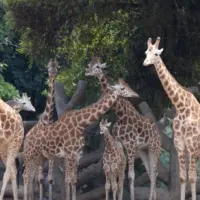
(LONDON) — Giraffes, long considered a single species, have now been recognized as four genetically distinct species in a major decision by the International Union for Conservation of Nature (IUCN) that scientists say could reshape conservation efforts across Africa.
The announcement comes after more than a decade of research by the Giraffe Conservation Foundation (GCF) and Germany’s Senckenberg Biodiversity and Climate Research Centre where scientists found that the genetic differences between the four species — Masai, northern, reticulated, and southern — are as significant as those between brown bears and polar bears.
“This recognition is more than academic,” said Dr. Julian Fennessy, GCF’s Director of Conservation. “Each giraffe species faces different threats, and now we can tailor conservation strategies to meet their specific needs.”
The most at-risk is the northern giraffe, with fewer than 6,000 individuals left in the wild, while the reticulated giraffe, mostly found in northern Kenya, is estimated at around 16,000 — though that is more than a 50% decrease from the 36,000 individuals estimated to have lived 35 years ago.
The Masai giraffe, a common sight in Tanzania’s national parks, has a population of approximately 45,400. Only the southern giraffe, whose numbers count approximately 49,850 individuals, is considered relatively stable by GCF.
According to GCF’s 2025 status report, giraffes have disappeared from almost 90% of the regions once considered prime habitats, including several West African countries where they are now extinct.
“This announcement will surprise many — how could we have overlooked something so fundamental?” said Fennessy. “But it underscores the importance of combining fieldwork with genetics to drive real-world conservation outcomes.”
The current classification had remained unchanged since 1758, when all giraffes were placed under a single species. That view persisted until 2016 when researchers first published genetic data suggesting deeper divisions.
The studies involved DNA samples from thousands of giraffes collected across 21 African countries, along with a recently published morphological study of giraffe skulls. The findings led the IUCN’s Giraffe and Okapi Specialist Group to formally recognize four species this week.
“To describe four new large mammal species after more than 250 years of taxonomy is extraordinary,” said Prof. Axel Janke. “Especially for animals as iconic as giraffe, which roam Africa in plain sight.”
The new classification could lead to a change in global conservation policies and each species will now be independently assessed for the IUCN Red List, opening the door to targeted protections under agreements like the U.S. Endangered Species Act, which is currently considering a listing for giraffes.
The move also allows countries to potentially direct conservation funding more precisely.
The GCF says the next step is to implement species-specific strategies, including habitat protection, anti-poaching patrols and community conservation, instead of treating giraffes as a uniform population.
“What a tragedy it would be to lose a species we only just learned existed,” said Stephanie Fennessy, GCF’s Executive Director.
Copyright © 2025, ABC Audio. All rights reserved.














